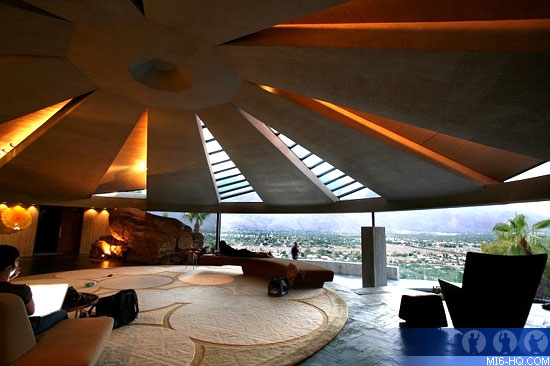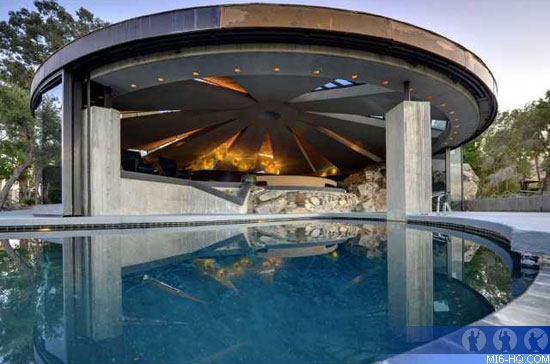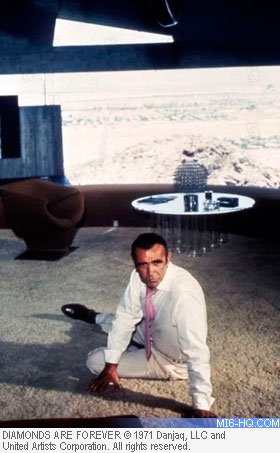 |
| |
Step inside the Elrod House and discover the rich history behind this remarkable "Diamonds Are Forever" location...
|
|
Inside Elrod House
6th October 2010
In the world of James Bond everything is dramatic,
exotic and grand, and the environments in which he finds himself
are certainly no exception. Among the most memorable are those
by production designer Ken Adam, who was responsible for many of the iconic sets we see in the early Bond films. However, one standout location is not a set at all, but an actual existing house. It is The Elrod House in Palm Springs by architect John Lautner.

"...I wanted to look at exotic looking places in Palm Springs...and I was shown [the Elrod House] and it was absolutely right for the film. It was a reinforced concrete structure, very modern and fabulous. I said ‘this as though I designed it. I don't have to do anything.'" - Ken Adam.
|
The Elrod House is house featured prominently in "Diamonds Are Forever" as Willard Whyte's winter retreat. The exposed rock of the desert floor encroaching into the living space along with the angular, vaulted ceiling, made this seem like something straight out of production designer Ken Adam's imagination, and was in perfect keeping with the James Bond design ethic of bold, dramatic environments.
The production team was able to negotiate the rights to shoot at many of the Las Vegas locations through the use of Cubby Broccoli's powerful connections, one of whom was Los Angeles lawyer, Sidney Korshak, renowned as one of Hollywood's most influential fixers and at one time called "the most powerful lawyer in the world" by the FBI.
 "The connection that Cubby had that allowed us to do some very interesting filming...was somebody called Sidney Korshak. I had lunch with Sidney in a bistro in Beverly Hills... The next day I flew to Vegas and was met by a big black limo and was shown any house I wanted to look at." - Ken Adam.
"The connection that Cubby had that allowed us to do some very interesting filming...was somebody called Sidney Korshak. I had lunch with Sidney in a bistro in Beverly Hills... The next day I flew to Vegas and was met by a big black limo and was shown any house I wanted to look at." - Ken Adam. |
Initially, the owner of The Elrod House was quite reluctant to allow filming to take place there, however, after a single phone call from Cubby to Korshak, the permission was granted.
"The gentleman who [owned the property] was not all that helpful," Ken Adam recalled. "So, I immediately got a hold of Cubby, Cubby rang Sidney, and within half an hour we had the house."
Securing The Elrod House for "Diamonds Are Forever" proved to be inspired and allowed the iconic Bond franchise to ally itself with the creation of one of the Twentieth Century's most gifted architects.
"There's an architect called [John] Lautner, a very famous architect, [who has] done some incredible buildings, and he built that house. I found it very impressive... that was a beautiful, very interesting house." - Jill St. John.
Lautner was apprenticed to the architect Frank Lloyd Wright in his early years and learned much from his mentor, as is evidenced by some of the architectural flourishes incorporated in many of his homes.
Lautner was passionate about the relationship between the natural environment and the structures he created, striving to create a harmonious balance and determined to humanise the spaces of the built world. |
|

Above: Sean Connery on set at Elrod House in 1971.
|
The Elrod House, possibly his most famous residence, is an excellent example of this desire for a communication between the landscape and the home, and for there to be a sense of awe and drama in the design.
Built in 1968 for interior designer Arthur Elrod, The Elrod House was designed to shield the home from the intense desert sun. The massive domed roof is sliced into sections that have been raised out to accommodate skylights and provide indirect light and rests on sweeping concrete walls.
The Elrod House is built on a difficult site, and when Lautner saw that grading had exposed rock on 23 acre site, he directed the contractor to dig 10 feet deeper, uncovering massive rocks that would eventually become an integral part of the interior itself, as can be seen in "Diamonds Are Forever", as Thumper lounges upon one of the rocks when Bond enters the house.
As is evident when watching "Diamonds Are Forever", the Elrod House has a modest entrance that conceals the soaring space from the roadside. Upon entering, you are greeted a panoramic view of the Palm Springs desert, the heavy concrete roof structure seemingly floating and spaces that interplay with the divide between the interior and exterior.
Lautner's homes have made appearances in several films, including the "Charlie's Angels Full Throttle" and "The Big Lebowski", as well as inspiring the Malibu home of Tony Stark in the "Iron Man" films; however, it is The Elrod House in "Diamonds Are Forever" that stands out above the rest.
Lautner is often a misunderstood architect, and some critics mistake his desire to create a dramatic interplay between the environment and the spaces he created as nothing more than flamboyant artistic gestures. However, nothing could be further from the truth. Lautner's homes may have become synonymous with playboy excesses and the Hollywood elite, but this is a mile away from Lautner's commitment to creating harmonious and humanised living spaces.
That The Elrod House looks as dramatic and imaginative as any of the iconic sets of the Bond universe is a testament to the brilliance of Lautner's design.
Article by Ben Williams.